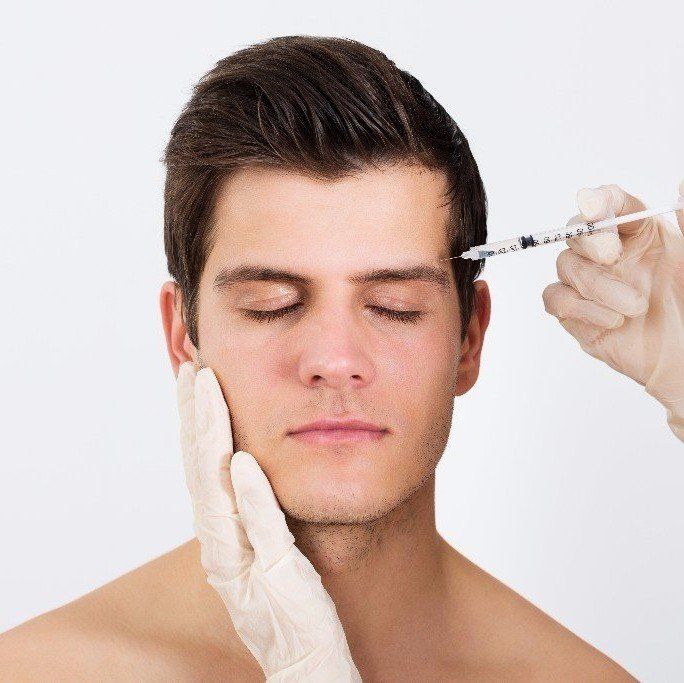ANTI-WRINKLE INJECTIONS



At a glance....
12 weeks
Average longevity
15 minutes
Duration of appointment
Botox by Allergan
Product used
Introduction
Anti-wrinkle injections are an excellent way to smooth and soften unwanted facial lines, including forehead creases, crow’s feet, smoker’s lines, and frown lines (often called “11s” between the brows).
These treatments use Botulinum Toxin A, a prescription medicine that is carefully injected into targeted facial muscles using very fine needles. At KITA-Aesthetics, we use the Allergan-manufactured brand Botox. Your practitioner will assess your facial muscles and determine the precise injection points for optimal results. The effects develop gradually, typically becoming noticeable within 7–10 days.
Once injected, Botulinum Toxin A attaches to a specific protein (SNARE) at the nerve endings responsible for sending chemical signals to muscles. It blocks the release of acetylcholine, the neurotransmitter that triggers muscle contraction. By preventing these signals, the muscle relaxes and the overlying skin appears smoother.
Although the toxin binds quickly, it can take up to two weeks for the full effect to develop, results are not immediate.
How long does it last?
The effects of treatment typically last an average of 12 weeks following the initial session. Muscle activity generally begins to return gradually around 8 weeks post-treatment, meaning the “frozen” effect will gradually soften and is not expected to remain throughout the full 12-week period. Most clients notice a reduction in maximal effect from approximately 6 weeks onward.
This treatment aims to improve the appearance of fine lines; however, it does not create a flawless or completely wrinkle-free result if static lines are already present. Static lines caused by skin thinning will not be fully corrected with Botulinum Toxin alone, and additional treatments may be recommended to address these concerns.
Please be aware that while botulinum toxin is designed to reduce muscle movement, complete elimination of movement is not guaranteed. Some clients may not achieve a fully “frozen” appearance, and outcomes can vary based on individual anatomy and muscle strength.
What are the risks and side effects?
Allergies and side effects to Botulinum Toxin A treatment are extremely rare. The results of treatment cannot be guaranteed. Most people find that the injections cause only mild discomfort. Immediately after the treatment, there may be mild swelling, which usually disappears after 30 mins.
Afterwards, the injection site can be slightly red for about one hour. In a small number of cases a bruise may occur.
Rare side effects include: headache, nausea and flu-like symptoms. In very rare cases patients may also develop antibodies or allergies to the toxin, experience double-vision and watering eyes.
If you are pregnant or a breastfeeding mother or sufferer from neuromuscular diseases such as Bells palsy or Myasthenia Gravis, treatment is not recommended.
For treatment of the upper face, such as frown and forehead, there is a very low risk of brow ptosis (where the brow cannot move at all and feels 'heavy') or eyelid ptosis (drooping of the eyelid), which completely reverses with time.
For treatment in the lower areas of the face, as the treatment involves the temporary relaxation of the muscles, your facial movements will change and feel different. For example, with treatment of muscles relating to the lips there is a strong likelihood that control of your lips will feel different, i.e. you may be unable or find it harder to drink from a straw, to whistle, find it difficult applying lipstick in your usual way or you may need to adjust the way to drink from a glass as you will be unable to tense your treated lip to the same extent as you could before treatment. It can take some time to get used to a new sensation, but the effect will reverse over time and you will return to your normal movement.
Please be aware that we do not offer 'Botox brow lifts' at KITA-AESTHETICS.
Which areas can be treated?
Each area is an average of 24 units.
24 units of Botox - Average 1 area
50 units of Botox - Average 2 areas
75 units - Average 3 areas
100 units - Average 4 areas
The muscle group (frontalis) that is responsible for moving the eyebrows up and down (the middle/top of the forehead) that create the horizontal lines in the middle/top of the forehead (Average dose 24 units)
The muscle group (glabella) which is between the brows and a little above the eyebrow that make the eyebrows go inwards to prevent the creases forming between the brows (Average dose 24 units)
Crows feet (both side) which crease when smiling (Average dose 24 units)
Bunny lines which are lines that are created when the nose is creased (Average dose 24 units)
Masseters (jawline muscles) to prevent the jawline muscles from clenching as hard for those who have large jawline muscles (Average dose 50 units)
Chin to prevent dimpling of the chin or creasing just below the lip (Average dose 24 units)
Perioral lines (lines above the lip) to lessen the puckering of the skin around the mouth. Please note that Botox here can affect speech and eating. For static lines already present at rest Botox will only prevent these creases from becoming deeper (Average dose 20 units)
Gummy Smile to prevent the top lip being pulled up as high to reduce the exposure of the gums when smiling (Average dose 24 units)
Doses per individual may vary per area
